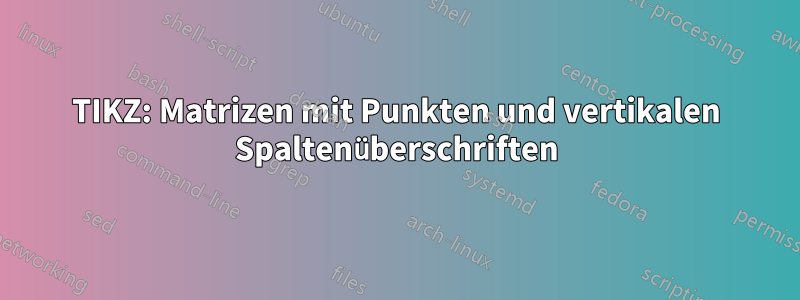
Ich stecke bei diesem Diagramm in Tikz völlig fest:
Insbesondere habe ich keine Ahnung, wie ich diese Punkte erzeugen soll. Ein weiteres Problem ist die Überschrift der Matrizen. Eigentlich wollte ich jede Spalte mit einem vertikalen Text beschriften.
Jede Hilfe oder Idee ist willkommen!
Danke
Marcel
Antwort1
Hier ist der Code mit tikz
\documentclass[a4paper]{article}
\usepackage[left=0.2cm,right=1cm]{geometry}
\usepackage{tikz,xcolor}
\usepackage{amsmath}
\usepackage{graphicx}
\usepackage{scalerel}
\usetikzlibrary{matrix,positioning,shapes}
\tikzstyle{square}=[minimum size=0.5cm,draw]
\tikzstyle{myrec}=[rectangle, minimum width=3.1cm, minimum height=1.6cm, text centered, draw=black,text width=3cm]
\newcommand{\mydot}{\raisebox{-0.2ex}{\hspace*{-0.5mm}\LARGE\bfseries ...}}
\newcommand\xdownarrow[1][2ex]{\mathrel{\rotatebox{90}{$\xleftarrow{\rule{#1}{0pt}}$}}}
\begin{document}
\begin{center}
\begin{tikzpicture}
\def\square;{\node[square](a1){};\node[square,right of=a1,xshift=-5mm](a2){};\node[square,right of=a2,xshift=-5mm](a3){};\node[right of=a3,scale=0.7mm,xshift=-2.0mm](d1){...};\node[square,right of=d1,xshift=-4mm](d2){};\node[square,right of=d2,xshift=-5mm]{};}
\node[] at (-6.7,3.3) (b1) {$\overbrace{~~~~~~~~~~~~~~~~~~~~~~~~~~~}$};
\node[right of=b1,xshift=2.5cm] (b2) {$\overbrace{~~~~~~~~~~~~~~~~~~~~~~~~~~~}$};
\node[right of=b2,xshift=2.7cm] (b3) {$\overbrace{~~~~~~~~~~~~~~~~~~~~~~~~~~~}$};
\node[right of=b3,xshift=2.5cm] (b4) {$\overbrace{~~~~~~~~~~~~~~~~~~~~~~~~~~~}$};
\node[rotate=-90] at (6.5,0) (c) {$\overbrace{~~~~~~~~~~~~~~~~~~~~~~~~~~~~~}$};
\node[right of=c,scale=1.5,xshift=0.3cm] {Op-Code};
\node[scale=1.5,xshift=0.3cm] at (-9,0) {~~~~~~~~~~~~~};
\node[above of=b2,yshift=1cm,xshift=2cm,scale=2] {\bfseries Control Table};
\node[above of=b1,yshift=-0.3cm,text width=1.5cm,text centered] {Control Signals};
\node[above of=b2,yshift=-0.3cm,text width=2.6cm,text centered] {Micro-Sequenzer Instruction};
\node[above of=b3,yshift=-0.3cm,text width=2.6cm,text centered] {Condition Selector};
\node[above of=b4,yshift=-0.3cm,text width=2.0cm,text centered] {Branch Address};
\draw[->] (-9,1.5)-- (-8,1.5);
\node at (-10.0,1.5) {\bfseries\large Micro-PC};
\matrix (M)[matrix of math nodes,rectangle,draw,xshift=-1.3cm]
{
\square; &\hspace{-0.5mm}& \square; &\hspace*{-3.5mm}& \square;&\hspace{-0.5mm}&\square; \\
\square; &\hspace{-0.5mm}& \square; &\hspace*{-3.5mm}& \square;&\hspace{-0.5mm}&\square; \\
\square; &\hspace{-0.5mm}& \square; &\hspace*{-3.5mm}& \square;&\hspace{-0.5mm}&\square; \\
\square; &\hspace{-0.5mm}& \square; &\hspace*{-3.5mm}& \square;&\hspace{-0.5mm}&\square; \\
& & & \node[scale=0.7mm] {\vdots}; & & & \\
\square; &\hspace{-0.5mm}& \square; &\hspace*{-3.5mm}& \square;&\hspace{-0.5mm}&\square; \\
\square; &\hspace{-0.5mm}& \square; &\hspace*{-3.5mm}& \square;&\hspace{-0.5mm}&\square; \\
\square; &\hspace{-0.5mm}& \square; &\hspace*{-3.5mm}& \square;&\hspace{-0.5mm}&\square; \\
\square; &\hspace{-0.5mm}& \square; &\hspace*{-3.5mm}& \square;&\hspace{-0.5mm}&\square; \\
};
\end{tikzpicture}
\vspace{-0.7mm}
$\xdownarrow[1cm]$
\begin{tikzpicture}
\def\square;{\node[square](a1){};\node[square,right of=a1,xshift=-5mm](a2){};\node[square,right of=a2,xshift=-5mm](a3){};\node[right of=a3,scale=0.7mm,xshift=-2.0mm](d1){...};\node[square,right of=d1,xshift=-4mm](d2){};\node[square,right of=d2,xshift=-5mm]{};}
\matrix (N)[matrix of math nodes,rectangle,draw]
{
\square; &\hspace{-0.5mm}& \square; &\hspace{-0.5mm}& \square;&\hspace{-0.5mm}&\square; \\
};
\node[myrec] at (-5.2,-2.5) (r1) {Datapath};
\node[myrec,right of=r1,xshift=2.5cm] (r2) {Micro Sequenzer Instruction};
\node[myrec,right of=r2,xshift=2.5cm] (r3) {Condition Selector};
\node[myrec,right of=r3,xshift=2.5cm] (r4) {Branch Address};
\node[above of=r1,yshift=0.5cm] {$\xdownarrow[1cm]$};
\node[above of=r2,yshift=0.5cm] {$\xdownarrow[1cm]$};
\node[above of=r3,yshift=0.5cm] {$\xdownarrow[1cm]$};
\node[above of=r4,yshift=0.5cm] (side) {$\xdownarrow[1cm]$};
\node[text width=3.5cm,text centered] at (9,0) {Active Control Signals};
\node[text width=3.5cm,text centered] at (-8,0) {~~~};
\end{tikzpicture}
\end{center}
\end{document}
Antwort2
Eine Lösung mit tikz. Ich habe zwei Schleifen verwendet, um die Blöcke aus 3+2 kleinen Quadraten zu positionieren. In jedem Block sind die Knoten ganz links und ganz rechts benannt und können zum Positionieren von Pfeilen und anderen Dingen verwendet werden.
\documentclass[border=5mm]{standalone}
\usepackage{tikz}
\usetikzlibrary{calc,decorations.pathreplacing,fit,positioning}
\begin{document}
\begin{tikzpicture}[%
node distance=1mm and 1mm,
SmallSq/.style={inner sep=0mm,minimum size=5mm,draw},
CurlyBrace/.style={decorate,decoration={brace,amplitude=5pt}},
CurlyBraceMirror/.style={decorate,decoration={brace,amplitude=5pt,mirror}},
TextBox/.style={pos=0.5,yshift=3mm,anchor=west,rotate=90,text width=3cm},
FrameTextBox/.style={draw,text width=2.5cm, minimum width=2.8cm,minimum height=1.5cm,below,align=center},
]
\newcommand\SqRowDist{3.3}
\foreach \x in {0,1,2,3}{
\foreach \y in {-2,1,2,3,4,6,7,8,9}{
\node[SmallSq] (SqL\x\y) at (\x*\SqRowDist,\y*0.6){};
\node[SmallSq] at (\x*\SqRowDist+0.5,\y*0.6){};
\node[SmallSq] at (\x*\SqRowDist+1,\y*0.6){};
\node at (\x*\SqRowDist+1.5,\y*0.6){$\cdots$};
\node[SmallSq] at (\x*\SqRowDist+2,\y*0.6){};
\node[SmallSq] (SqR\x\y) at (\x*\SqRowDist+2.5,\y*0.6){};
}
}
\node[draw,fit=(SqL01)(SqR39)](BigSq){};
\node[draw,fit=(SqL0-2)(SqR3-2)](LowSq){};
\node at ($(SqR14.north east)!0.5!(SqL26.south west)$){$\vdots$};
%%
\draw[latex-] (SqL07.west) -- +(-1,0)node[left]{Micro PC};
\draw[CurlyBrace] ($(SqL09.north west)+(0,0.2)$)--($(SqR09.north east)+(0,0.2)$) node[TextBox]{Control signal};
\draw[CurlyBrace] ($(SqL19.north west)+(0,0.2)$)--($(SqR19.north east)+(0,0.2)$) node[TextBox]{Micro-Sequencer Instruction};
\draw[CurlyBrace] ($(SqL29.north west)+(0,0.2)$)--($(SqR29.north east)+(0,0.2)$) node[TextBox]{Condition Selector};
\draw[CurlyBrace] ($(SqL39.north west)+(0,0.2)$)--($(SqR39.north east)+(0,0.2)$) node[TextBox]{Branch Address};
%%
\draw[-latex]({$(SqL0-2)!0.5!(SqR0-2)$} |- LowSq.south) -- +(0,-1) node[FrameTextBox]{Datapath};
\draw[-latex]({$(SqL1-2)!0.5!(SqR1-2)$} |- LowSq.south) -- +(0,-1) node[FrameTextBox]{Micro-Sequencer Instruction};
\draw[-latex]({$(SqL2-2)!0.5!(SqR2-2)$} |- LowSq.south) -- +(0,-1) node[FrameTextBox]{Condition Selector};
\draw[-latex]({$(SqL3-2)!0.5!(SqR3-2)$} |- LowSq.south) -- +(0,-1) node[FrameTextBox]{Branch Address};
%%
\draw[CurlyBraceMirror] ($(SqR32.south east)+(0.2,0)$)--($(SqR37.north east)+(0.2,0)$) node[pos=0.5,xshift=3mm,right]{OP code};
\node[right] at ($(LowSq.east)+(0.2,0)$){Active Control Signals};
\end{tikzpicture}
\end{document}





